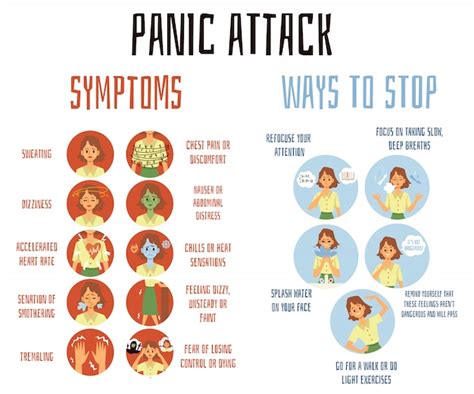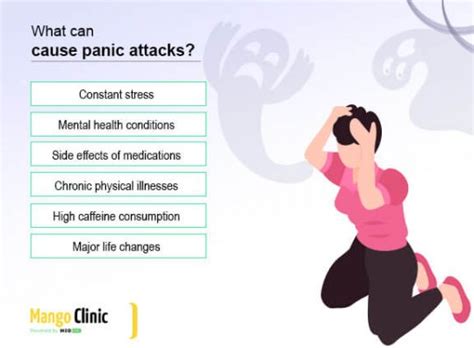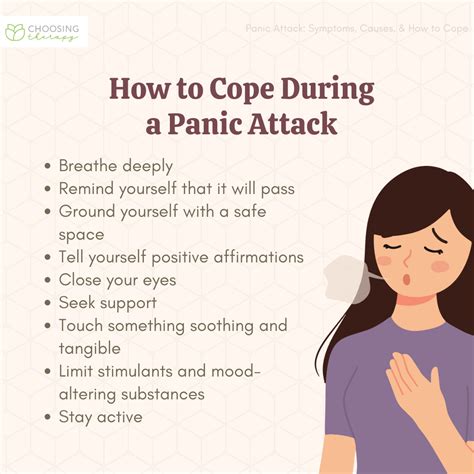Intro
Discover panic attack symptoms, causes, and treatment options. Learn to recognize signs of anxiety, panic disorder, and coping mechanisms to manage stress and phobias, alleviating intense fear and worry.
Panic attacks are a common and often debilitating condition that affects millions of people worldwide. These sudden episodes of intense fear or discomfort can strike at any time, leaving individuals feeling overwhelmed, anxious, and helpless. Despite their prevalence, panic attacks remain shrouded in mystery, with many people struggling to understand their causes, symptoms, and treatment options. In this article, we will delve into the world of panic attacks, exploring their symptoms, triggers, and consequences, as well as providing valuable insights and advice for those affected.
Panic attacks are often characterized by a range of physical and emotional symptoms, which can vary in severity and duration. These symptoms can be so intense that they may lead individuals to believe they are experiencing a heart attack, stroke, or other life-threatening condition. The fear of losing control, going crazy, or dying is a common theme among those who experience panic attacks. This fear can be so overwhelming that it may lead to avoidance behaviors, where individuals avoid certain situations, places, or activities that they associate with panic attacks.
The importance of understanding panic attack symptoms cannot be overstated. By recognizing the warning signs and taking proactive steps, individuals can learn to manage their symptoms, reduce their frequency and severity, and improve their overall quality of life. Moreover, educating oneself about panic attacks can help to alleviate the stigma and misconceptions surrounding this condition, promoting a more supportive and compassionate environment for those affected.
Panic Attack Symptoms

Panic attack symptoms can be broadly categorized into physical, emotional, and behavioral symptoms. Physical symptoms may include a racing heart, sweating, trembling, shortness of breath, and nausea. Emotional symptoms, on the other hand, may involve feelings of intense fear, anxiety, or dread, as well as a sense of detachment or unreality. Behavioral symptoms, such as avoidance behaviors, can also be a significant aspect of panic attacks.
Physical Symptoms of Panic Attacks
Physical symptoms of panic attacks can be intense and debilitating, making it difficult for individuals to function normally. Some common physical symptoms include: * Rapid heartbeat or palpitations * Sweating, trembling, or shaking * Shortness of breath or difficulty breathing * Nausea or abdominal discomfort * Dizziness or lightheadedness * Chills or hot flashes * Tingling or numbness in the hands or feetCauses and Triggers of Panic Attacks

Panic attacks can be triggered by a range of factors, including stress, anxiety, genetics, and environmental factors. Understanding the causes and triggers of panic attacks is essential for developing effective treatment strategies. Some common causes and triggers of panic attacks include:
- Stress and anxiety
- Genetics and family history
- Trauma and adverse life events
- Substance abuse or withdrawal
- Medical conditions, such as hyperthyroidism or heart disease
- Certain medications or supplements
Emotional and Behavioral Symptoms of Panic Attacks
Emotional and behavioral symptoms of panic attacks can be just as debilitating as physical symptoms. Some common emotional and behavioral symptoms include: * Intense fear or anxiety * Feelings of dread or doom * Sense of detachment or unreality * Avoidance behaviors, such as avoiding certain situations or places * Hypervigilance, such as being constantly on the lookout for potential threats * Difficulty concentrating or making decisionsTreatment Options for Panic Attacks

Fortunately, there are several effective treatment options available for panic attacks. These may include:
- Cognitive-behavioral therapy (CBT), which helps individuals identify and challenge negative thought patterns and behaviors
- Medications, such as antidepressants or benzodiazepines, which can help alleviate symptoms of anxiety and panic
- Relaxation techniques, such as deep breathing, progressive muscle relaxation, or mindfulness meditation
- Lifestyle changes, such as regular exercise, healthy eating, and stress management
Self-Help Strategies for Managing Panic Attacks
In addition to seeking professional help, there are several self-help strategies that can help individuals manage panic attacks. Some of these strategies include: * Keeping a panic diary to track symptoms and identify triggers * Practicing relaxation techniques, such as deep breathing or progressive muscle relaxation * Engaging in regular exercise, such as walking or yoga * Avoiding stimulants, such as caffeine or nicotine * Getting enough sleep and maintaining a healthy dietCoping with Panic Attacks

Coping with panic attacks requires a combination of self-help strategies, professional treatment, and support from loved ones. Some tips for coping with panic attacks include:
- Seeking support from friends and family
- Joining a support group or online community
- Practicing self-compassion and self-care
- Learning to recognize and challenge negative thought patterns
- Developing a crisis plan, such as identifying a safe place or having a emergency contact
Preventing Panic Attacks
Preventing panic attacks is possible by making lifestyle changes, managing stress and anxiety, and seeking professional help. Some tips for preventing panic attacks include: * Practicing relaxation techniques, such as deep breathing or progressive muscle relaxation * Engaging in regular exercise, such as walking or yoga * Getting enough sleep and maintaining a healthy diet * Avoiding stimulants, such as caffeine or nicotine * Learning to recognize and challenge negative thought patternsConclusion and Final Thoughts

In conclusion, panic attacks are a common and treatable condition that can have a significant impact on an individual's quality of life. By understanding the symptoms, causes, and treatment options, individuals can take proactive steps to manage their symptoms and improve their overall well-being. Remember, you are not alone, and there is help available. Don't be afraid to reach out to a mental health professional or a support group for guidance and support.
We invite you to share your thoughts and experiences with panic attacks in the comments section below. Your input can help others who may be struggling with this condition, and we appreciate your feedback.
What are the symptoms of a panic attack?
+Panic attack symptoms can include a racing heart, sweating, trembling, shortness of breath, and nausea, as well as feelings of intense fear, anxiety, or dread.
What causes panic attacks?
+Panic attacks can be triggered by a range of factors, including stress, anxiety, genetics, and environmental factors, such as trauma or substance abuse.
How can I manage panic attacks?
+Managing panic attacks requires a combination of self-help strategies, professional treatment, and support from loved ones. This can include practicing relaxation techniques, seeking therapy, and making lifestyle changes, such as regular exercise and healthy eating.
